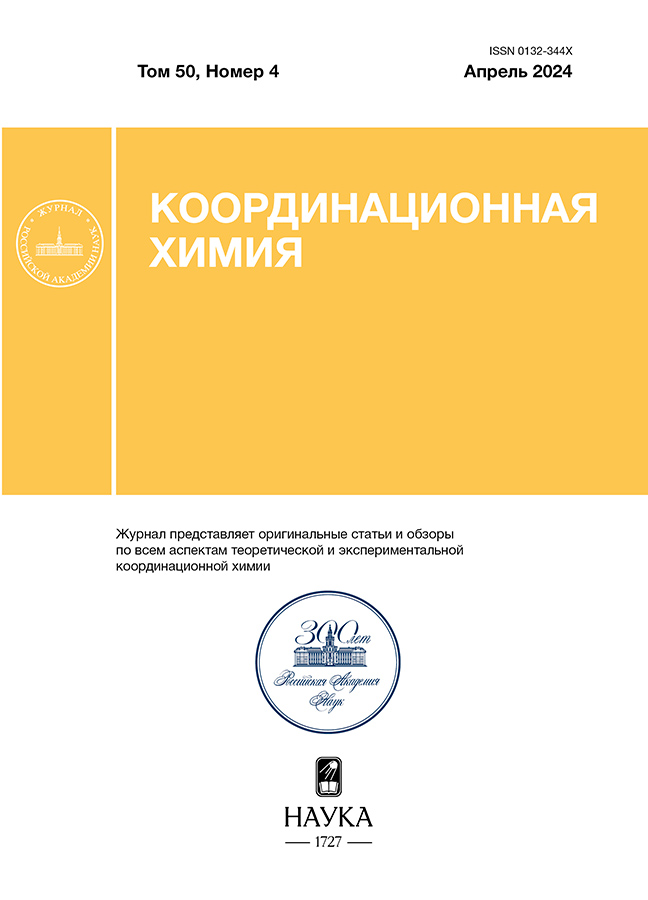Diamidophosphine as a Precursor of the Iminophosphonamidinate Ligand in the Yttrium Complex
- Autores: Konokhova A.Y.1, Afonin M.Y.1, Sukhikh T.S.1, Konchenko S.N.1
-
Afiliações:
- Nikolaev Institute of Inorganic Chemistry, Siberian Branch, Russian Academy of Sciences
- Edição: Volume 50, Nº 4 (2024)
- Páginas: 261-269
- Seção: Articles
- URL: https://cardiosomatics.ru/0132-344X/article/view/667606
- DOI: https://doi.org/10.31857/S0132344X24040046
- EDN: https://elibrary.ru/NPKTJP
- ID: 667606
Citar
Texto integral
Resumo
Diamidophosphine tBuP(NHMes)2(H2L) is synthesized by the treatment of tBuPCl2 with two equivalents of KNHMes (Mes = 2,4,6-Me3C6H2). The reaction of H2L with potassium hydride in THF (THF is tetrahydrofuran) affords the anionic form HL− with the hydrogen atom migrating from nitrogen to phosphorus, which is confirmed by the 1H and 31P NMR data. The structure of the formed iminophosphonamidinate anion HL− is determined by X-ray diffraction (XRD) in the crystalline phase of K[K(THF)2](tBuPH(NMes)2)2 · C7H8 (KHL). The reaction of KHL with yttrium chloride gives complex [Y(tBuPH(NMes)2)2Cl] ([Y(HL)2Cl]) in which, according to the XRD data, ligands HL− are in the iminophosphonamidinate PH form. The 1H and 31P NMR spectra confirm that this structure of the complex exists in the solution.
Texto integral
Sobre autores
A. Konokhova
Nikolaev Institute of Inorganic Chemistry, Siberian Branch, Russian Academy of Sciences
Email: konch@niic.nsc.ru
Rússia, Novosibirsk
M. Afonin
Nikolaev Institute of Inorganic Chemistry, Siberian Branch, Russian Academy of Sciences
Email: konch@niic.nsc.ru
Rússia, Novosibirsk
T. Sukhikh
Nikolaev Institute of Inorganic Chemistry, Siberian Branch, Russian Academy of Sciences
Email: konch@niic.nsc.ru
Rússia, Novosibirsk
S. Konchenko
Nikolaev Institute of Inorganic Chemistry, Siberian Branch, Russian Academy of Sciences
Autor responsável pela correspondência
Email: konch@niic.nsc.ru
Rússia, Novosibirsk
Bibliografia
- Kissel, A.A. and Trifonov, A.A., INEOS OPEN, 2018, vol. 1, no. 1, p. 1.
- Trifonov, A.A., Coord. Chem. Rev., 2010, vol. 254, nos. 1–2, p. 1327.
- Collins, S., Coord. Chem. Rev., 2011, vol. 255, nos. 1–2, p. 118.
- Groom, C.R., Bruno, I.J., Lightfoot, M.P., et al., Acta Crystallogr., Sect. B: Struct. Sci., Cryst. Eng. Mater., 2016, vol. 72, p. 171.
- Schumann, H., Winterfeld, J., Hemling, H., et al., Chem. Ber., 1995, vol. 128, no. 4, p. 395.
- Recknagel, A., Steiner, A., Noltemeyer, M., et al., J. Organomet. Chem., 1991, vol. 414, no. 3, p. 327.
- Liu, B., Li, L., Sun, G., et al., Macromolecules, 2014, vol. 47, no. 15, p. 4971.
- Liu, B., Sun, G., Li, S., et al., Organometallics, 2015, vol. 34, no. 16, p. 4063.
- Nekrasov, R.I., Peganova, T.A., Fedyanin, I.V., et al., Inorg. Chem., 2022, vol. 61, no. 40, p. 16081.
- Kalsin, A.M., Peganova, T.A., Sinopalnikova, I.S., et al., Dalton Trans., 2020, vol. 49, no. 5, p. 1473.
- Goswami, B., Feuerstein, T.J., Yadav, R., et al., Chem.-Eur. J., 2021, vol. 27, no. 61, p. 15110.
- Vrana, J., Jambor, R., Ruzicka, A., et al., Dalton Trans., 2015, vol. 44, no. 41, p. 4533.
- Kolodiazhnyi, O.I. and Prynada, N., Tetrahedron Lett., 2000, vol. 41, no. 41, p. 7997.
- Kolodiazhnyi, O.I. and Andrushko, N.V., Russ. J. Gen. Chem., 2001, vol. 71, p. 1819.
- Khisamov, R.M., Sukhikh, T.S., Konchenko, S.N., et al., Inorganics, 2022, vol. 10, no. 12, p. 263.
- Kormachev, V.V., Fedoseev, M.S., Preparativnaya khimiya fosfora (Preparative Chemistry of Phosphorus), Perm′: UrO RAN, 1992, p. 100.
- Sheldrick, G.M., Acta Crystallogr., Sect. A: Cryst. Adv., 2015, vol. 71, no. 1, p. 3.
- Sheldrick, G.M., Acta Crystallogr., Sect. C: Struct. Chem., 2015, vol. 71, no. 1, p. 3.
- Dolomanov, O.V., Bourhis, L.J., Gildea, R.J., et al., J. Appl. Crystallogr., 2009, vol. 42, no. 2, p. 339.
- Petrov, P.A., Smolentsev, A.I., Konchenko, S.N., et al., Polyhedron, 2017, vol. 129, no. 17, p. 60.
- Valdebenito, G., Parra-Melipan, S., Lopez, V., et al., Appl. Organomet. Chem., 2021, vol. 35, no. 11, p. 6382.
- Gongoll, M., Peitz, S., Muller, B.H., et al., Phosphorus. Sulfur. Silicon Relat. Elem., 2013, vol. 188, no. 12, p. 1845.
- Li, S., Cui, D., Li, D., et al., Organometallics, 2009, vol. 28, no. 16, p. 4814.
- Li, S., Miao, W., Tang, T., et al., Organometallics, 2008, vol. 27, no. 4, p. 718.
- Schumann, H., Winterfeld, J., Hemling, H., et al., Chem. Ber., 1995, vol. 128, no. 4, p. 395.
- Yang, Y., Lv, K., Wang, L., et al., Chem. Commun., 2010, vol. 46, no. 33, p. 6150.
- Sroor, F., Hrib, C., and Edelmann, F., Inorganics, 2015, vol. 3, no. 4, p. 429.
- Rufanov, K.A., Pru, N.K., and Sundermeyer, J., Dalton Trans., 2016, vol. 45, no. 4, p. 1525.
- Anga, S., Acharya, J., and Chandrasekhar, V., Org. Chem., 2021, vol. 86, no. 3, p. 2224.
Arquivos suplementares














